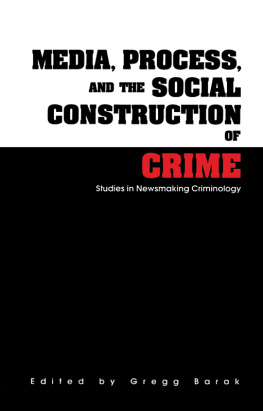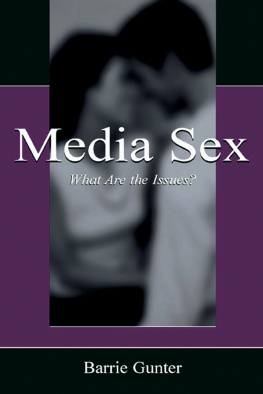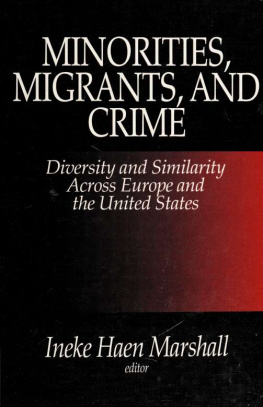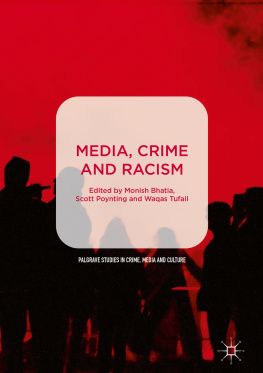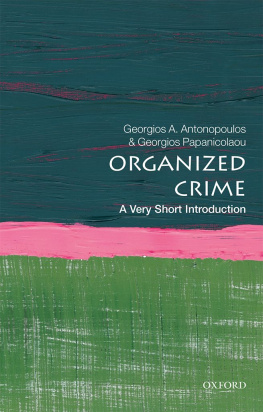Media and Crime in the U.S.
FOR INFORMATION:
SAGE Publications, Inc.
2455 Teller Road
Thousand Oaks, California 91320
E-mail: order@sagepub.com
SAGE Publications Ltd.
1 Olivers Yard
55 City Road
London EC1Y 1SP
United Kingdom
SAGE Publications India Pvt. Ltd.
B 1/I 1 Mohan Cooperative Industrial Area
Mathura Road, New Delhi 110 044
India
SAGE Publications Asia-Pacific Pte. Ltd.
3 Church Street
#10-04 Samsung Hub
Singapore 049483
Copyright 2018 by SAGE Publications, Inc.
All rights reserved. No part of this book may be reproduced or utilized in any form or by any means, electronic or mechanical, including photocopying, recording, or by any information storage and retrieval system, without permission in writing from the publisher.
Printed in the United States of America
Library of Congress Cataloging-in-Publication Data
Names: Jewkes, Yvonne, author. | Linnemann, Travis, author.
Title: Media and crime in the U.S. / Yvonne Jewkes, University of Brighton, Travis Linnemann, Eastern Kentucky University.
Description: Thousand Oaks : Sage, [2018] | Includes bibliographical references and index.
Identifiers: LCCN 2017009813 | ISBN 9781483373904 (pbk. : alk. paper)
Subjects: LCSH: Mass media and crimeUnited States. | Mass media and criminal justiceUnited States. | Crime in mass media.
Classification: LCC P96.C742 U639 2018 | DDC 364.0973dc23 LC record available at https://lccn.loc.gov/2017009813
This book is printed on acid-free paper.
Acquisitions Editor: Jessica Miller
Editorial Assistant: Jennifer Rubio
Content Development Editor: Laura Kirkhuff
Marketing Manager: Amy Lammers
Copy Editor: Rachel Keith
Typesetter: C&M Digitals (P) Ltd.
Proofreader: Dennis W. Webb
Indexer: Jean Casalegno
Cover Designer: Scott Van Atta
Introduction
As in so many other areas of social, economic, and political life, it may be true that the United States is exceptional when it comes to the ways in which it communicates about crime, violence, and disorder. A relentless fascination with serial killers, monstrous women, and youth gone mad is enacted across an expansive cultural register. But despite a long, dubious history, crime and media in the U.S. context arguably came into its own with a car chase broadcast live on national television on Friday, June 17, 1994. That morning, Los Angeles Police Department detectives contacted an elite Hollywood attorney named Robert Shapiro to advise him that one of his clients, O. J. Simpson, was wanted for questioning in the murders of his wife, Nicole Brown Simpson, and her friend Ronald Goldman. Later that day, when Simpson failed to surrender to police as arranged by Shapiro, a manhunt ensued. By 5 p.m., local news stations were live-broadcasting the parade of highway patrol vehicles tailing Simpsons white Ford Bronco down stretches of California highway as crowds of onlookers gathered on roadsides and overpasses.
The now-infamous chase served as the opening scene in a spectacular trial that unfolded over the next year and a half, captivating spectators worldwide and laying bare the many limitations of American criminal justice. Billed by many as the trial of the century, the criminal prosecution and eventual exoneration of the former NFL star undoubtedly served as a blueprint for the many televised criminal trials and crime infotainment programs that have followed. However, we should be careful to note that while the Simpson case unfolded on television in a unique, perhaps unheralded fashion, the American public has long been captivated by the lurid mysteries of violent crime. Even the moniker trial of the century predates broadcast television by nearly five decades. From the case of two narcissistic socialites, Nathan Leopold and Richard Loeb, who aimed to commit and get away with the perfect murder, to the trials of two Italian-born anarchists, Nicola Sacco and Bartolomeo Vanzetti, who were executed in 1927 for the supposedly politically inspired murders of two company guards, the American cultural landscape has long been scarred by high-profile crimes and their attendant courtroom spectacles.

Photo I.1 The chase for OJ Simpson and his infamous white Ford Bronco.
ZUMA Press, Inc./Alamy Stock Photo
Today, when surveying the U.S. media landscape, it is as though one horrific crime bleeds into the next. In this way, we might say that representations of crime in the U.S. take the shape of what the late cultural theorist Raymond Williams called flow. In a continuous stream of mundane and spectacular crime storiesfrom newspaper accounts of local arrests, nightly news broadcasts of the days top stories, police procedurals ripped from the headlines, and big-budget Hollywood films to social media feeds and stories shared between friendscrime and its mediated representations perpetually circulate in the whirring background of everyday life. Even today we can trace the cultural reverberations of the Simpson case in the FX miniseries The People v. OJ Simpson: An American Crime Story and a multipart installment of the popular ESPN documentary film series 30 for 30 focusing on the intersection of celebrity, sport, and crime. In fact, if we consider that Robert Kardashian gained national prominence as Simpsons attorney, we might say that his daughters considerable fame flows directly from the notorious trial.


